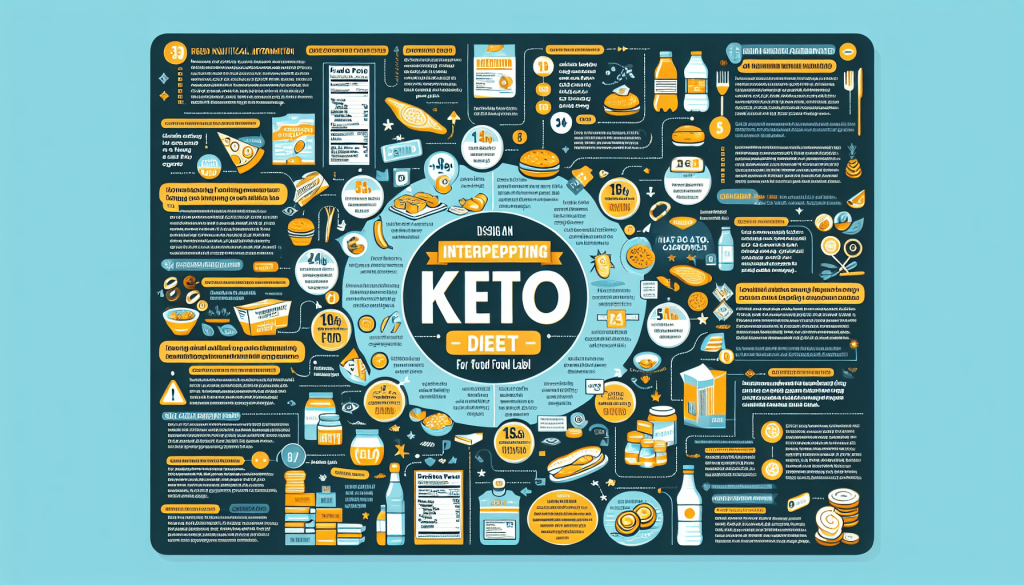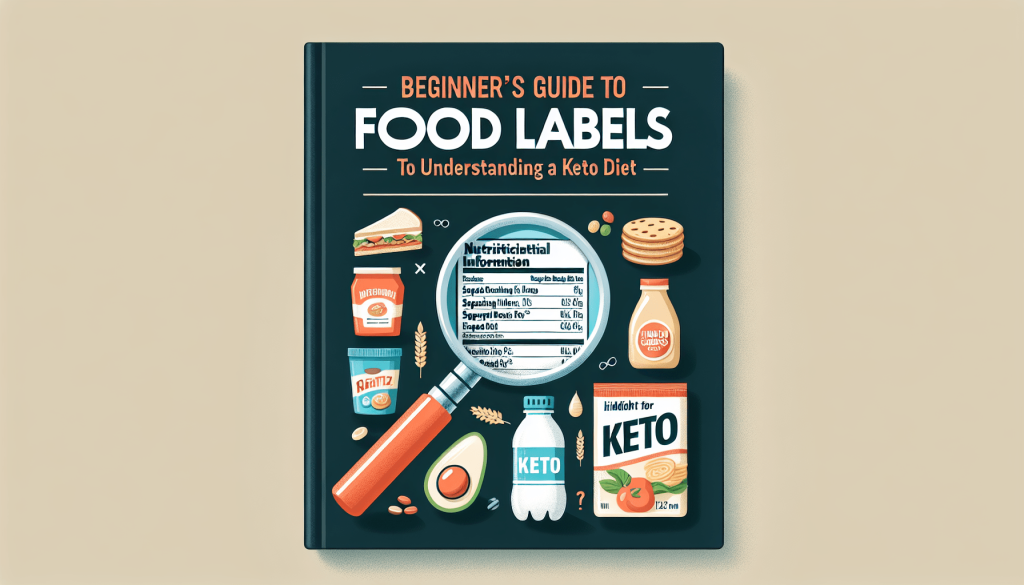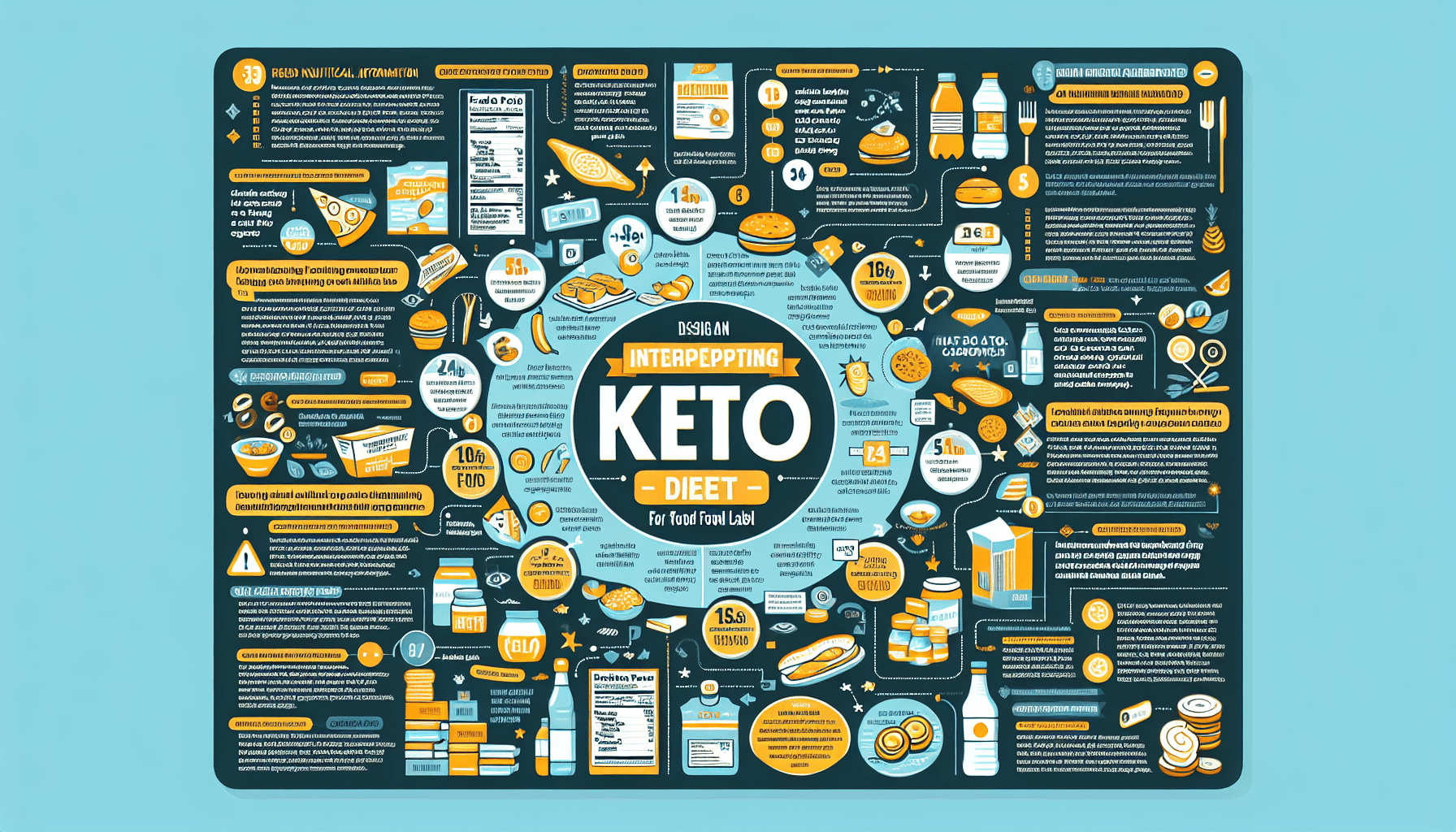So, you’re embarking on a keto diet journey and want to make sure you’re on the right track with your food choices. Understanding how to read food labels is an essential skill that will help you navigate the aisles of the grocery store confidently. In this beginner’s guide to reading food labels on a keto diet, we’ll break down everything you need to know about deciphering those nutrition facts and ingredient lists, making it easier for you to stay within your low-carb, high-fat goals. Get ready to make informed choices and keep your keto lifestyle on track!
Understanding Macronutrients
Eating a balanced diet is important for maintaining a healthy lifestyle, and macronutrients play a crucial role in this. Macronutrients are the three main components of our diet: carbohydrates, fats, and proteins. Understanding these macronutrients is essential for making informed choices about the food we eat. By identifying carbohydrates, recognizing healthy fats, and determining protein content, you can create a well-rounded meal plan that supports your overall health and wellness.
Identifying carbohydrates
Carbohydrates are often misunderstood and can be a bit tricky to navigate, especially when following a keto diet. Carbohydrates are found in many foods, including fruits, vegetables, grains, and sugars. However, not all carbohydrates are created equal. When reading food labels, it’s important to identify the different types of carbohydrates.
On food labels, you will typically find two types of carbohydrates: total carbohydrates and net carbohydrates. Total carbohydrates include all forms of carbohydrates, including fiber and sugar alcohols. Net carbohydrates, on the other hand, only include the carbohydrates that have an impact on your blood sugar levels. This is especially important for those on a keto diet where the goal is to limit the intake of carbohydrates that can spike insulin levels.
Recognizing healthy fats
Contrary to popular belief, fats are an essential part of a healthy diet. However, not all fats are created equal. When reading food labels, it’s important to recognize the different types of fats and choose healthy sources.
Saturated fats are usually solid at room temperature and are commonly found in animal products such as meat and dairy. While they shouldn’t be completely eliminated from your diet, it’s important to consume them in moderation, as excessive intake may increase the risk of heart disease.
On the other hand, unsaturated fats, including monounsaturated and polyunsaturated fats, are considered healthy fats. These fats can be found in foods like avocados, nuts, seeds, and certain oils. They can help improve cholesterol levels and reduce the risk of heart disease when consumed in appropriate amounts.
Determining protein content
Protein is an essential macronutrient that plays a vital role in many bodily processes. When reading food labels, it’s important to determine the protein content to ensure you are meeting your daily requirements.
Protein can be found in both animal and plant-based sources. Animal sources include meat, poultry, fish, eggs, and dairy products. Plant-based sources include legumes, tofu, tempeh, and certain grains. By incorporating a variety of protein-rich foods into your diet, you can ensure you are getting all the necessary amino acids your body needs.
Total Carbohydrates
Calculating net carbs is a crucial step when following a keto diet. Net carbs refer to the carbohydrates that have a significant impact on blood sugar levels. By understanding how to calculate net carbs, you can make more informed choices about the foods you consume.
Calculating net carbs
To calculate net carbs, you subtract the grams of fiber and sugar alcohols from the total carbohydrates. This gives you a more accurate representation of the carbohydrates that affect your body’s insulin response. As a general rule on a keto diet, it is recommended to keep net carbs below a certain limit, typically around 20-50 grams per day, to achieve and maintain a state of ketosis.
Avoiding hidden sugars
Hidden sugars are often lurking in foods we least expect. When reading food labels, it’s important to be mindful of ingredients that may indicate the presence of hidden sugars. Common sources of hidden sugars include high fructose corn syrup, dextrose, sucrose, and maltose. These sugars can add up quickly and significantly impact your daily carbohydrate intake.
By familiarizing yourself with these hidden sugar sources and actively avoiding them, you can better manage your carbohydrate intake and stay on track with your keto journey.
Impact of sugar alcohols
Sugar alcohols are commonly used in sugar-free and low-carb products as a sweetener alternative. They provide sweetness without the same impact on blood sugar levels as regular sugar. While sugar alcohols are often subtracted from total carbohydrates to calculate net carbs, it’s important to note that they can still have some effect on blood sugar levels, depending on the individual. It’s best to monitor your body’s response to these sugar alcohols and adjust your intake accordingly.

Fiber Content
Fiber is a key component of a healthy diet, and it plays a particularly important role when following a keto diet. Understanding the importance of fiber, identifying fiber sources, and including fiber in net carb calculations are essential for a well-rounded meal plan.
Importance of fiber on a keto diet
Fiber is a type of carbohydrate that is not digested by the body. Instead, it passes through the digestive system relatively intact. This property of fiber makes it an excellent addition to a keto diet as it can help regulate blood sugar levels, promote healthy digestion, and keep you feeling fuller for longer.
Identifying fiber sources
When reading food labels, it’s crucial to identify good sources of fiber. Foods such as leafy greens, broccoli, cauliflower, flax seeds, chia seeds, and avocados are all great sources of fiber that can be easily incorporated into a keto meal plan.
Including fiber in net carb calculations
When calculating net carbs, it’s important to consider the fiber content of the food. Since fiber is not digested by the body, it doesn’t have an impact on blood sugar levels. Therefore, it can be subtracted from the total carbohydrates, giving you a more accurate representation of the carbs that affect your body’s insulin response.
By including fiber in net carb calculations, you can increase your daily carbohydrate allowance while still maintaining a state of ketosis.
Serving Size
Understanding portion sizes is essential when reading food labels on a keto diet. It’s easy to fall into the trap of overeating, especially when the serving sizes listed on labels may not align with our own perceptions. By understanding portion sizes, adjusting macros for different servings, and avoiding portion distortion, you can better manage your overall calorie and macronutrient intake.
Understanding portion sizes
The serving sizes listed on food labels may not always reflect the amount you typically consume. Take note of the serving size stated on the label and compare it to the amount you plan to eat. This will help you accurately calculate the nutritional information based on your intended portion.
Adjusting macros for different servings
When adjusting macros for different servings, it’s important to understand that the nutrient content listed on the label is based on the serving size mentioned. If you plan to consume a larger or smaller portion, you will need to adjust the macros accordingly.
For example, if the serving size on the label is 30 grams, and you plan to eat 60 grams, you will need to double the nutritional information to accurately represent the macros in your portion.
Avoiding portion distortion
Portion distortion occurs when we underestimate or overestimate the actual serving size of a food. This can lead to consuming more or fewer calories and macronutrients than we intended. To avoid portion distortion, be mindful of the serving sizes listed on food labels and use measuring cups or a food scale to accurately measure your portions. This will ensure you are staying within your desired calorie and macronutrient ranges.

Net Carb Calculation
Calculating net carbs is a fundamental aspect of a keto diet. By subtracting fiber from total carbs and accounting for sugar alcohols, you can determine the net carb content of the food you consume and stay within your desired carbohydrate range.
Subtracting fiber from total carbs
Fiber is not digested by the body, so it doesn’t have the same impact on blood sugar levels as other carbohydrates. When calculating net carbs, subtract the grams of fiber from the total carbohydrates to get a more accurate representation of the carbs that affect your body’s insulin response.
For example, if a food contains 10 grams of total carbohydrates and 5 grams of fiber, the net carbs would be 5 grams (10 grams – 5 grams = 5 grams net carbs).
Accounting for sugar alcohols
Sugar alcohols are a type of carbohydrate that can provide sweetness without the same impact on blood sugar levels as regular sugar. While they are often subtracted from total carbohydrates to calculate net carbs, it’s important to be aware that sugar alcohols can still have some effect on blood sugar levels, depending on the individual.
If a food contains sugar alcohols, it’s best to monitor your body’s response and adjust your intake accordingly to stay within your desired carbohydrate range.
Determining net carb limits
The recommended net carb limit on a keto diet typically ranges from 20-50 grams per day. However, it’s important to note that individual tolerance levels may vary. Some people may need to consume fewer net carbs to achieve and maintain a state of ketosis, while others may be able to tolerate slightly higher net carb intake.
It’s crucial to listen to your body, monitor your blood sugar levels, and adjust your net carb intake accordingly to meet your specific goals and needs.
Fat Content
Understanding the different types of fats, choosing healthy fat sources, and avoiding trans fats are key considerations when reading food labels on a keto diet.
Differentiating between saturated and unsaturated fats
Fats are often categorized as saturated or unsaturated, and it’s important to understand the difference between the two. Saturated fats are typically solid at room temperature and are commonly found in animal products like meat and dairy. Unsaturated fats, on the other hand, are typically liquid at room temperature and are found in plant-based sources like avocados, nuts, and certain oils.
While saturated fats should be consumed in moderation, unsaturated fats are considered healthy fats and can be incorporated into a well-rounded keto diet.
Choosing healthy fat sources
When reading food labels, it’s important to choose healthy fat sources. Look for foods that contain monounsaturated and polyunsaturated fats, as these have been shown to support heart health and overall wellbeing. Some examples of healthy fat sources include avocados, nuts, seeds, olive oil, and fatty fish like salmon and mackerel.
Avoiding trans fats
Trans fats are artificially created fats that can have a detrimental effect on heart health. They are typically found in processed and fried foods. When reading food labels, avoid foods that contain hydrogenated or partially hydrogenated oils, as these are indications of trans fats.
By choosing healthy fat sources and avoiding trans fats, you can ensure you are incorporating fats into your diet that support your overall health and wellness.
Protein Content
Protein is an important macronutrient that plays a vital role in many bodily processes. When reading food labels on a keto diet, it’s important to determine the protein content to ensure you are getting an adequate amount.
Determining protein needs on a keto diet
The amount of protein you need on a keto diet may vary depending on your individual goals and activity level. As a general guideline, it is recommended to consume around 0.6-1.0 grams of protein per pound of body weight per day. This can help support muscle growth and repair, as well as other essential functions in the body.
Identifying protein sources
Protein can be found in both animal and plant-based sources. Animal sources of protein include meat, poultry, fish, eggs, and dairy products. Plant-based sources of protein include legumes, tofu, tempeh, and certain grains.
By incorporating a variety of protein-rich foods into your diet, you can ensure you are getting all the necessary amino acids your body needs.
Monitoring excessive protein intake
While protein is essential, it’s important to be mindful of excessive protein intake. Consuming too much protein on a keto diet can potentially kick you out of ketosis. Additionally, excessive protein intake may put a strain on your kidneys and can lead to other health complications.
It’s crucial to find the right balance of protein for your individual needs and monitor your intake to ensure you are staying within the recommended range.
Hidden Ingredients to Avoid
When reading food labels on a keto diet, it’s important to be aware of hidden ingredients that may hinder your progress. Identifying hidden sugars, avoiding high-carb additives, and recognizing artificial sweeteners are key considerations when looking for keto-friendly options.
Identifying hidden sugars
Hidden sugars are often found in processed foods, sauces, and condiments. Common sources of hidden sugars include high fructose corn syrup, dextrose, sucrose, and maltose. These sugars can quickly add up and significantly impact your daily carbohydrate intake.
Reading the ingredient list and looking out for these hidden sugar sources can help you make more informed choices and avoid unnecessary carbohydrates.
Avoiding high-carb additives
Some food additives can be high in carbohydrates and can unknowingly sabotage your keto efforts. Ingredients like maltodextrin, cornstarch, and other thickeners can elevate the carbohydrate content of the food.
By being mindful of these high-carb additives, you can make more educated decisions about the foods you choose to incorporate into your keto meal plan.
Recognizing artificial sweeteners
Artificial sweeteners are often used as sugar alternatives in low-carb and sugar-free products. While they may not directly impact blood sugar levels, some individuals may experience gastrointestinal distress or other side effects from consuming artificial sweeteners.
It’s important to be aware of the artificial sweeteners used in food products and monitor your body’s response to them. Experiment with different sweetener options to find the ones that work best for you.
Allergens and Sensitivities
If you have any food allergies or sensitivities, it’s essential to read food labels carefully when following a keto diet. Spotting common allergens, identifying gluten-free options, and understanding dairy content are important considerations for those with specific dietary needs.
Spotting common allergens
Common allergens, such as peanuts, tree nuts, soy, dairy, eggs, wheat, fish, and shellfish, are often listed on food labels. By reading the ingredient list, you can quickly identify the presence of these allergens and make informed choices that align with your dietary restrictions.
Identifying gluten-free options
For individuals with gluten sensitivities or celiac disease, finding gluten-free options is important. It’s crucial to carefully read food labels to ensure that the products you are consuming are certified gluten-free or made with gluten-free ingredients.
Understanding dairy content
Some individuals may be lactose intolerant or have sensitivities to dairy products. When reading food labels, it’s important to check for the presence of dairy ingredients. Alternatively, look for dairy-free alternatives that suit your dietary needs.
By being mindful of allergens and sensitivities, you can ensure that the foods you consume align with your specific dietary requirements and preferences.
Additional Considerations
When reading food labels on a keto diet, there are a few additional considerations to keep in mind. Checking for preservatives and additives, understanding organic vs. non-organic labels, and evaluating nutritional claims can provide further insights into the quality and suitability of the foods you choose.
Checking for preservatives and additives
Some food products may contain preservatives and additives that could be detrimental to your health or hinder your progress on a keto diet. When reading food labels, look out for ingredients like additives, artificial colors, and preservatives that may not align with your dietary goals. Opt for whole foods and minimally processed options whenever possible.
Understanding organic vs. non-organic labels
Organic produce and products have become increasingly popular due to their perceived superiority in terms of quality and sustainability. When reading food labels, take note if the product is labeled as organic and understand what that means in terms of farming practices and certification. While organic options can be beneficial, it’s important to note that not all non-organic foods are inherently unhealthy.
Evaluating nutritional claims
Food labels often make various claims about the nutritional value or health benefits of the product. While these claims can be informative, it’s important to consider them critically and understand that they may not always provide the full picture. Take the time to read the entire food label, including the ingredient list and nutritional information, to make a well-informed decision about the product’s suitability for your keto diet.
By considering these additional factors, you can make more informed choices about the foods you consume and support your overall health and wellness goals on a keto diet.
In conclusion, reading food labels on a keto diet is essential for making informed choices and maintaining a well-rounded meal plan. By understanding macronutrients, calculating net carbs, identifying fiber sources, determining serving sizes, accounting for fat and protein content, avoiding hidden ingredients, considering allergens and sensitivities, and evaluating additional factors, you can successfully navigate food labels and create a sustainable keto diet that supports your overall health and wellness.
